Niki's Story
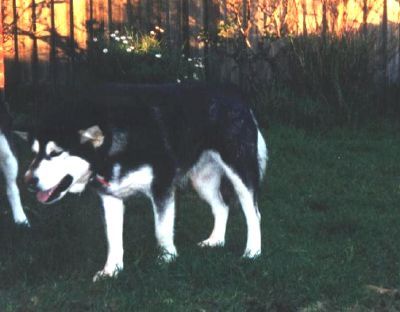
Photo - Niki at around 5 years of age, before the thyroid problem.
In hindsight, I believe Niki’s problem started around the middle of 1999. I had her de-sexed in September 1999 and her weight had crept up from 38 kilos to 45 kilos. I had not weighed her for quite some time and the extra weight was not really that noticeable. Niki is a solid bitch, almost 25 inches at the shoulder and could carry the extra weight quite well. I reduced her food and left it at that. Her weight stayed pretty constant at 45 kilos and I just put it down to her being de-sexed.
In the early part of 2000, she started to develop sores on her feet that would not heal with antibacterial creams but eventually went away of their own accord. In June I discovered the most enormous, what appeared to be a hot spot, on her back. It covered almost half her back. Niki was not prone to hot spots and in fact she had never had one before. Eventually it healed but I always thought it was strange. Niki’s coat was looking very dull around this time and she was constantly shedding hair. Again, I just put the coat problem down to her being de-sexed.
I came home from work one night in September 2000 and Niki was laying on her hammock bed. She didn’t get up to greet me which I thought was unusual. She just laid there wagging her tail. I went inside and about half an hour later she started howling/talking to me so I went outside to see why as she wasn’t normally very vocal. She was still laying there. I walked toward her and called her. That’s when I realised she had a problem. When she tried to get up, she was screaming in pain. It was like her back end just wouldn’t work. She couldn’t seem to get her legs up under her. It was heartbreaking to see her this way. How long had she been like this?
To cut a long story short, with great difficulty, I took her to the vet. It took me 2 hours to get her off the bed and I helped to support her with a towel under her holding her up. We both thought she had a back problem. The vet x-rayed her spine and there was nothing obviously wrong with it. We put her on an anti-inflammatory medication as a precaution as it might have been a soft tissue type injury and I kept her crated inside overnight. Her weight at this time was 49 kilos. She would not settle in the crate and woke me every hour or so to let her out. In the end, I put Niki in the kennel that I had set up under my carport so I could get some sleep.
The next morning, I discovered blood in her urine where she had urinated on the concrete. Back to the vet and he confirmed a bladder infection. She had blood and protein in her urine and a low specific gravity (this is what regulates urine concentration). She also had an elevated white blood cell count, consistent with an infection. She was on antibiotics for 3 weeks and this cleared up. Her specific gravity also returned to normal for which I was thankful. This can indicate a kidney problem if it remains low. If I had not put Niki outside that night, I would never have picked this up.
I weighed Niki in December 2000 and she was 52.2 kilos. She was 49 kilos when we had the x-ray done 3 months prior. I was very concerned and requested a full blood panel be done. Everything came back normal but the weight gain was really bothering me.Niki could not even walk around the block. She would lag behind me to the end of her lead. Sometimes she would stop and just refuse to go any further. However she always found the energy to get home when we turned around.
Niki was of course on an extremely strict diet yet she was still gaining weight. She was now 53.8 kilos. This was the heaviest she became before everything turned around. In total, Niki had gained around 16 kilos. I tried absolutely everything in the way of food to ensure she had enough to fill her but it also had to be not too fattening. It was really hard to find something that would work. Every time I tried something new, I would confidently think to myself, this will work. Then I’d weigh her and she had gained yet another kilo.
After what seemed like forever with the dietary problem, I found something that eventually seemed to work. I would feed her one 700gm can of Pal daily as it has a very low protein content. She had no dry food, no fresh meat, no treats and one carrot every other day. This for a dog that used to eat 3 cups of Eagle and treats on a regular basis. Even with the drastically reduced food intake, she only lost 2 kilos over the next 2 months.
In late December 2000, she developed an ear infection. She was constantly shaking her head and walking around in circles with her head tilted to one side. We used an entire bottle of ear drops and it still did not clear up. I started to suspect a thyroid problem after doing my own research on the internet. Whenever I put her symptoms into a search, one common diagnosis kept coming up and yes, that was hypothyroidism.
I mentioned this to my vet but he didn’t think it was a thyroid problem as she had lost 2 kilos. I mean for crying out loud, I was feeding the poor dog next to nothing. Of course she would lose some weight. She had also developed another symptom which I had noticed recently and that was fatty deposits on the cornea of the eye. This is due to a cholesterol build up caused by the thyroid problem. I was convinced it was a thyroid problem and eventually requested that he test the Free T4 level (a good indicator of thyroid problems). We had the first test done in February 2001 and sure enough it came back at <5.2. The normal range is (5.5 – 25*) although most normal dogs are between 10 – 15*. (*This can vary depending on which laboratory does the blood test) With all the clinical symptoms that Niki had and the low T4, he started her on 2 Oroxine tablets daily (thyroid hormone replacement).
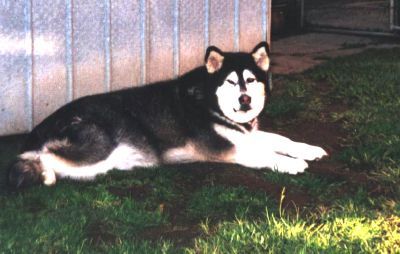
Niki 5 months after commencing medication at 7 years of age. You can see how plump she looks in the photo.
What followed was an absolute nightmare. Niki should have shown some improvement within a month. There was no improvement and she gained 1 kilo. We did another blood test and checked her TSH (Thyroid Stimulating Hormone) assay. This is usually, but not always, elevated in a hypothyroid dog and if elevated, will confirm the diagnosis. Niki’s was 0.03 (<0.50) while within the normal range, it was at the very low end which I thought was a bit strange.We were both still sure of the diagnosis so increased her medication. Over the next few months we alternated between blood tests, increasing medication and further research. Eventually her Free T4 had increased to around 7, although she still had not lost any weight. Niki was now on 8 tablets per day.
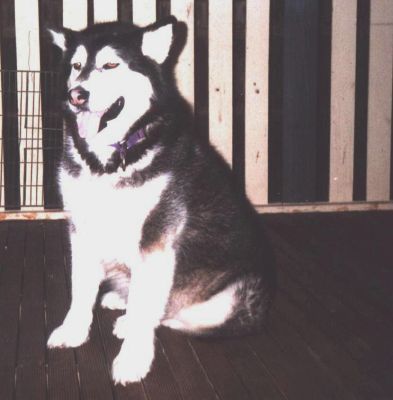
Niki 6 months after starting medication. You can see how fat and uncomfortable she looks.
Finally the break through. In September of 2001, she dropped 10 kilos in what appeared to be overnight. We re-tested her Free T4 and she was around 13. Well within normal range. The following 12 months entailed careful monitoring of Niki’s condition. I could not change her diet as it’s very important to feed the same way so as to assess the effectiveness of the medication by regular monthly weigh-ins. If you increase the food, you won’t know if a weight gain is caused by the extra food or not enough Oroxine. I will add that since the initial 10 kilo weight loss in September 2001, Niki also had 1 cup of Eagle which I introduced gradually starting with a quarter of a cup and she also had regular treats and a lamb shank once a week. Initially she might have gained a kilo but it soon leveled out. In February 2003 Niki weighed 35.2 kilos. This was the lightest she has ever been so her medication was reduced to one tablet per day.
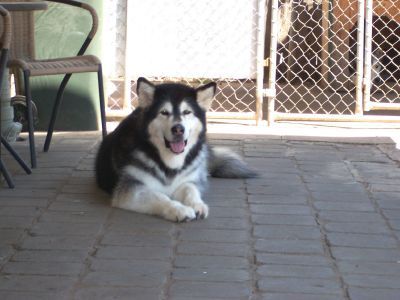
Niki 3rd January 2004 looking a lot more comfortable.
I was a little bit concerned about her weight but she looked healthy and happy. With a thyroid problem, too much medication is worse than not enough. They can become the opposite - “hyperthyroid”. Niki’s normal weight has always been between 38 – 40 kilos. So as you can see, 35.2 kilos is a cause for concern. If a dog becomes hyperthyroid, they will become very restless, lose weight and drink excessive amounts of water. It’s so important to adjust the medication if they lose too much weight because if you don’t, your dog can go into a coma and die.
Too many dogs are misdiagnosed with hypothyroidism and I’m sure you can imagine the outcome if you give an excessive dose of Oroxine to a dog that is not hypothyroid. On the other hand, if they are not treated for hypothyroidism, eventually all their organs will just shut down and they would certainly die. Although how any owner could not notice a problem by the time it got to this stage is beyond my comprehension.
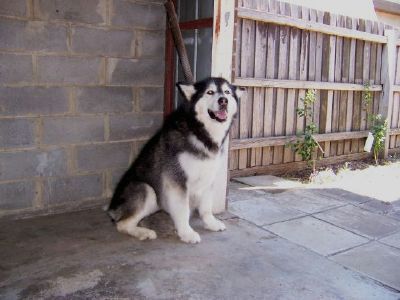
My gorgeous happy Niki smiling at me. Almost 10 years of age.
At last it seemed, that I had Niki back almost to the way she was before. Niki looked very good for her age and was reasonably active and apart from developing Osteoarthritis in her knees and hips, she was relatively healthy. One thing that stands out in my mind from this experience, is that Hypothyroidism will make a dog in it’s prime, look very old and tired before their time.
Niki’s weight alternated between 33 kilos and 42 kilos. The medication was adjusted accordingly. If she was too light, I reduced the medication. If she started to gain weight, I increased it. It’s a trial and error thing but by weighing her regularly, I could see how she was responding to the medication. As at 3rd January 2004, Niki weighed around 40 kilos and was on 4 Oroxine tablets per day.
I have some very sad news. After everything that Niki has been through over the last few years, she made the journey to the Rainbow Bridge at around 1.00am on Wednesday 4th February 2004. I came home that night at around 7.00pm but had to go out again. I returned at about 11.15pm and Niki was distressed. She was whimpering and crying under her breath and she looked so relieved to see me. I watched her for about half an hour trying to work out what was wrong with her. It was then that I noticed that she looked rather fat around the stomach and ribcage area. I suspected bloat and immediately took her to the vet. They took an x-ray as she was not, in their opinion, overly distended. The x-ray did confirm bloat (gastric torsion) and it also showed 2 other things. The arthritis that Niki suffered from, was now right throughout her spine and there was a large dense mass showing on the x-ray in the stomach region.
The vet told me I had 2 choices. I could decide to go ahead with the surgery for bloat with only 40% chance of it not recurring within a month and the mass could turn out to be cancer anyway and if so, she may not have long to live or my other option was to put her down. I could not believe what I was hearing and I was absolutely devastated. I kept looking at the x-ray and looking at Niki through the tears streaming down my face trying to decide what to do. I changed my mind at least 4 times. In the end I decided to go with the 40% chance but I told my vet that if the mass turned out be cancer, I wanted them to let her go. I said my goodbyes just in case and left Niki in the hands of the gods and I prayed and prayed that she would be ok.
I received a phone call 45 minutes later to say that she was gone. The mass was in fact spleen cancer and a particularly aggressive form called Hemangiosarcoma.
It’s now been one week since Niki died and I feel so, so empty without her. Niki was so much more than a dog to me. She was my baby. She would wake me every morning the moment my alarm went off by barking at me and swiping me with her paw. She would follow me absolutely everywhere. She would lay outside the door when I went to the toilet, when I had a shower. I was always telling her to move as she was always in my way. She would dribble water all over the floor and howl non-stop when I played a malamute video. She slept beside my bed for the last 2 years of her life because that’s where she wanted to be. I spent so much time with Niki and I really feel like I have lost my best friend. I think Niki knew that she was loved well at least I hope she knew how much I loved her. Niki has been cremated and her ashes will take pride of place on my bedside table on the side she used to sleep along with her “Bunny”. Bunny was her most favourite thing in the whole world. Niki had Bunny for 8 years and she loved him dearly. He is still in one piece as she was so gentle with him.
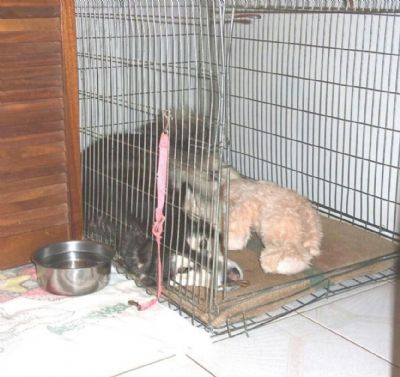
Niki and Bunny taken in 2003
Thank you Niki for giving me 10 years of unconditional love. You were my inspiration for this website and I’m so glad you stayed around long enough for it to come to fruition. Run free, without pain until we meet again at the Rainbow Bridge. I will carry you in my heart always.
